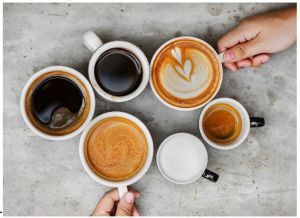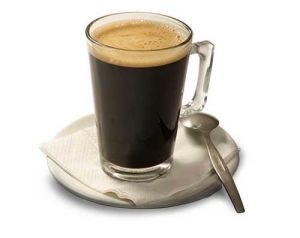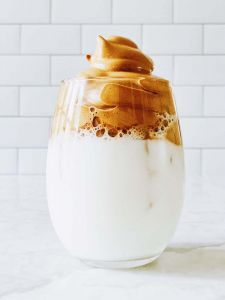
Regardless of why you’re drinking coffee, what matters most is how it tastes, smells, and whether or not it makes you feel alert and happy in the morning. That being said, everyone has their favourite order – perhaps a latte, a piccolo, or maybe a long black.
We checked online to see how many types of coffee beverages there are… it turns out, there are quite a lot. Over 30 different types of coffee were listed on one website, and more than 40 on another. To save us all some time, we’ll confine this list to the most commonplace coffees available, and what many Canstar Blue staff deem the most delicious.
Types of coffee: black
Espresso
Espresso is simply a shot of coffee, with no extra water added.
To make an espresso, shoot boiling water under high pressure through finely-ground coffee beans and then pour into a tiny cup. Sounds simple right? Well, it’s surprisingly difficult to master. Espressos are the purest coffee experience you can get, and while they’re not for everyone, it can be a truly singular drinking experience when you find a good brew.
You may hear some of us Kiwis and Aussies call it a short black.
Caffè Americano
You can make this type of coffee quite simply by adding hot water to a shot of espresso coffee. It has been said that American soldiers during WWII made this type of coffee to make their beverages last longer. It was then (apparently) adopted by American baristas after the war.
Long Black
A bit like the opposite of an Americano. Instead of pouring hot water over a shot of espresso, a long black is made by pouring a double-shot of espresso over hot water. By doing so it retains the crema (distinctive creamy head), and is usually stronger than an Americano.
Lungo
Italian for Long, a Lungo is an espresso that just doesn’t know when to stop. Unlike Americano or Long Black (which consists of water added to a shot of espresso), a Lungo is a shot of espresso that’s been pulled for longer. Essentially, instead of running some water through coffee beans for 20-30 seconds, you run about double the amount of water for double the time.
This results in a more watery and mild tasting coffee (as the coffee beans have been diluted through more water), yet with more caffeine and a more bitter taste (due to the beans being extracted for longer).

Types of coffee: with milk
Flat White
Possibly the most popular coffee here in New Zealand, no doubt thanks to originating here (or in Australia according to them). A flat white is made by pouring velvety steamed milk over a shot of espresso, with minimal froth.
Café Latte (or Café au lait)
Popular worldwide, though less so here thanks to our preference for flat whites, lattes consist of steamed milk and a small layer of milk froth. Like a flat white, with a little more volume on top.
Cappuccino
The frothiest and foamiest of the milky trio, the cappuccino is possibly the most popular type of coffee in the world. A cappuccino consists of three layers, kind of like a cake: equal parts espresso, steamed milk and foam. Although here in NZ, we tend to use a double-shot of espresso as the basis of all our coffee beverages. So your cappuccino may have a little more kick than cappuccinos elsewhere.
Traditionally, Italians consumed this type of coffee at breakfast.
Macchiato (also known as a Piccolo Latte)
A macchiato is a shot of espresso that is then topped off with foamed milk dashed directly into the cup. Although it may sound similar to a cappuccino, it’s usually stronger as there’s no steamed milk added. And it’s also smaller, usually served in an espresso-sized cup.
Mochaccino
A mocha is just a latte with added chocolate powder or syrup, sometimes topped with whipped cream. If anything, this is a good entry-level coffee – living in the world between the childlike hot chocolate and the adult café latte.
Types of Coffee: everything else
Filter Coffee
Technically all coffee is filtered, but filter coffee refers to steeping coffee beans in water, before then removing the beans and drinking the coffee-infused water. Whereas with espresso, you’re shooting boiling water under high pressure through finely ground coffee beans.
Filter coffee has long been the long black sheep of coffee, but has recently had a resurgence. A popular choice for those wanting a quick cuppa at home, or coffee connoisseurs, filter coffee is most commonly made using with a French press (plunger), or by pouring hot water over ground beans and filtering into a cup or mug below, like with a Chemex or Hario V60.
Irish Coffee
“Make it Irish” is a common joke, but an Irish coffee isn’t all that common a drink. Especially here in New Zealand, as it’s made with Irish whiskey, sugar, and a thick layer of cream on the top – so it isn’t readily available in New Zealand cafes due to its alcohol content.
Be warned, trying to make this with scotch and instant coffee doesn’t work… trust us!
Affogato
Affogatos aren’t really a coffee, as they’re a shot of espresso poured over a dessert, usually ice cream. That doesn’t make them any less delicious, though.

Dalgona
An internet sensation during the COVID-19 lockdown, I’m not entirely sure if anyone is actually making these anymore!
It’s made by whipping up instant coffee, sugar and hot water into a creamy froth and adding it to either hot or cold milk. It takes its name from the Korean word for honeycomb candy (as seen in Squid Game), which it resembles.
Instant
Okay, some caffeine snobs will turn their noses up at this one. But if you’re hiking or camping, or for emergencies at home, instant coffee is still better than no coffee! Instant coffee is coffee that’s had all the water removed, leaving behind just the soluble coffee flavour. Add the water back and, hey presto, something that tastes a bit like coffee!
While not the most delicious choice, it can certainly help save some cash. If you’re spending $4-$5 on coffee, five days a week, that can add up to over well over $1000 a year on your morning brew alone. And even if you can’t quite stomach a cup of instant, grabbing yourself a French press and plunging some coffee before you head out can still save plenty of cash. Without sacrificing quite as much of the flavour.
Compare with Canstar
Regardless of which type of coffee you drink, the cost of buying a cup of joe does add up. There’s a reason every internet article ever written about easy ways to save money includes cutting out your daily bought brew. And, yes, we’re just as guilty of overusing the tip here at Canstar too!
Why, because if you’re looking to better manage your finances, whether to pay off a personal loan, save for a mortgage or even put more cash towards your investments, you’ll want (or need) to cut back on some unnecessary spending. That might be a few less cups of coffee, or it might be finding a cheaper phone, broadband, or electricity plan.
Or, if you’re more interested in learning more about other consumer goods and appliances, like ovens, heat pumps, meal kit delivery providers and more, simply click the button below:

About the author of this page
This report was written by Canstar Content Producer, Andrew Broadley. Andrew is an
experienced writer with a wide range of industry experience. Starting out, he cut his teeth
working as a writer for print and online magazines, and he has worked in both journalism
and editorial roles. His content has covered lifestyle and culture, marketing and, more
recently, finance for Canstar.
Enjoy reading this article?
You can like us on Facebook and get social, or sign up to receive more news like this straight to your inbox.
By subscribing you agree to the Canstar Privacy Policy


Share this article